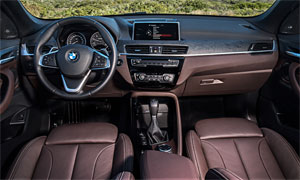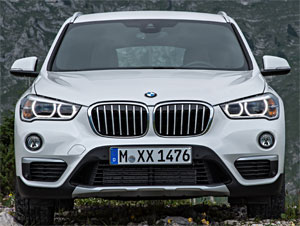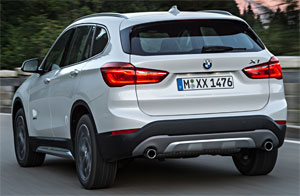2016 BMW X1
The BMW X1 was a true, early entry into the subcompact luxury crossover segment. But as is often the case, those that quickly follow are able to use your blueprint and improve upon it. Thus a new X1 has now been unleashed on the entry-level luxury loving streets of upscale suburbia. But there’s more new here than meets the eye.
The 2016 BMW X1 may not look all that unique from its predecessor; but it is indeed vastly different, riding on all-new architecture, and a front-wheel-drive based one at that.
Surely blasphemy to the BMW faithful. It’s all about baby steps, folks. BMW has already gotten you addicted to their SUVs, and now they slip in the front-drive architecture.
It doesn’t take a genius to figure out the reasons for that change; to drive costs down thanks to platform sharing with MINI, while bringing interior space up.
And there is indeed more room, especially in the back seat; but don’t expect midsize space here, it still feels smallish.
There’s also a bit more cargo space, climbing from 25.0 to 27.1 cubic-ft.; accessed by a standard power lift gate. Hands free operation is an option making the X1 a much more practical vehicle.
 And we do like our practicality, as does BMW; giving us functionality plusses like the 40/20/40 split-folding rear seats that slide and recline; as well as fold almost fully flat to expand the space to 58.7 cubic-ft.
And we do like our practicality, as does BMW; giving us functionality plusses like the 40/20/40 split-folding rear seats that slide and recline; as well as fold almost fully flat to expand the space to 58.7 cubic-ft.
All of the additional space wasn’t really a necessity, but it is much appreciated, making the X1 one of the roomiest in its class; now just about the perfect size for families either starting out or nearing the empty nester phase.
Still, the X1 retains that intimate feel that we love in a BMW, being surrounded by a luxury-clad, competently sporty vehicle. And not only are all materials inside improved, but everything seems more upscale in operation.
Well, everything except the front seats, that is. They are small, narrow, and uncomfortable almost to the point of being a deal breaker. And you definitely want to think twice about seats this light in color if kids are in your foreseeable future.
The X1 is initially available only in a single xDrive28i model. So despite a front-drive type chassis, it comes standard with all-wheel drive. As does an 8-speed automatic transmission and 18-inch wheels. Plenty of add-ons like head-up display and advanced safety features are available.
 Though I6 power is offered no more; only a 2.0-liter turbo I4. Still, 228–horsepower and 258 lb-ft. of torque easily puts it among class best.
Though I6 power is offered no more; only a 2.0-liter turbo I4. Still, 228–horsepower and 258 lb-ft. of torque easily puts it among class best.
We tried to make it sweat, but it responded by continuously delivering smooth and buzz-free trips to 60 in 6.3-seconds. It’s quite torquey off the line, with some front wheel spin before the rears kick in to compensate.
Gear changes were quick and firm, accompanied by a nice exhaust rasp throughout the 14.8-second ¼-mile run, which we completed at 94 miles-per-hour.
Even with the shift to a front-drive chassis, handling remains very rear-drive BMW-like. That’s not a big surprise, since this platform already deals out plenty of fun in the MINI Cooper. And, with all-wheel drive standard, it’s almost a guarantee that most buyers will not be able to tell the switch in chassis design.
Though we certainly could sense some additional understeer; body roll was kept well in check.
111–foot average stops from 60 is certainly not bad either, but braking performance was not quite up to the par we had in mind. Stops were inconsistent and the pedal felt soft with a fair amount of travel.
The X1 does appear more SUVish than before, and much better looking overall. But like most of the European crossover entries in this segment, still a little too “wagony” for our tastes.
 Most every dimension has increased, except for length; minus-1 overall, while the wheelbase shrinks by 3½-inches to 105.1.
Most every dimension has increased, except for length; minus-1 overall, while the wheelbase shrinks by 3½-inches to 105.1.
Government Fuel Economy Ratings are 22-City, 32-Highway, and 26-Combined. Our average was just 24.8 miles-per-gallon of Premium. Still, that makes for a better than average Energy Impact Score of 12.7-barrels of annual oil use with 5.7-tons of CO2 emissions.
X1 base pricing is a reasonable $35,795; but you can easily tack on another 10-grand in optional packages.
Oddly enough, going against just about everything BMW stands for, has made the 2016 BMW X1 one of our favorite BMWs; especially if you look at is as a sporty 5-door, not as an entry-level crossover.
It may not be the most capable or comfortable mini-ute on the market, but as you can expect, it’s one of the most fun. BMW has addressed anything we didn’t like before, as well as taken almost everything that we did like about the previous gen X1 and made it better. And most importantly, given us more of it.
Specifications
- Engine: 2.0 liter Turbo I4
- Horsepower: 228
- Torque: 258 lb-ft.
- 0-60 mph: 6.3 seconds
- 1/4 mile: 14.8 seconds @ 94 mph
- EPA: 22 mpg city/ 32 mpg highway
- Energy Impact: 12.7 barrels of oil/yr
- CO2 Emissions: 5.7 tons/yr
- Transmission: 8 spd automatic
2024 Polestar 2
More Range And More Power For The Polestar 2
Volvo is well on their way to making the transition to an all-electric brand, but their sister-brand Polestar is already there. Now, we’ve spent lots of time in their all-wheel drive, five-door Polestar 2, having tested it in 2021, and a year later when a two-wheel drive version arrived. But, EV updates are coming quickly. So, let us be your guide for all that’s new with the Polestar 2.
While we are driving more EVs than ever, we’ve also been spending a lot of time recently circling back to ones we’ve previously tested. As in this new era of electrified vehicles, significant updates are arriving quickly, with R&D investments increasing and retrofitting them easier than ever. This is often done through software updates that can even be accomplished over the air. For 2024, the Polestar 2 has indeed gotten some software updates, but some physical ones as well.
Clearly aimed directly at Tesla’s Model 3 when it arrived; the Polestar 2’s build quality was vastly better, but range definitely came up short. So, addressing that was priority No. 1; and for ’24 the Polestar can travel up to 20% farther than before while consuming 9% less energy, and when it comes time to charge it back up, it can do that 34% faster too.
Range in the Single Motor version increases from a max of 270 to 320 miles thanks to a larger 82-kWh battery pack, and that solitary motor now powers the rear wheels, not the front wheels. It’s also bigger, coming in at 220 kW compared to the previous 170 kW front-wheel drive version, going from 231 to 299 horsepower.
Dual Motors keep the same 78-kWh battery, but still sees a boost from 260 to 276 miles and takes advantage of the larger rear motor for a new combined 310-kW output with 421 horsepower. Our test car has the added Performance Pack, which uses an additional 35 kW to deliver 455 horsepower and 546 lb-ft of torque, though max range drops to just 247 miles.
The new battery in rear-drive 2s will also charge faster, now accepting up to 205 kW for an 80% charge in 20 minutes; max for dual-motors stays at 155 kW, which puts an 80% charge at 34 minutes. Using 32 kWh of electricity per 100 miles, the Dual Motor earns a good efficiency rating.
The [Polestar] 2 has always been one of the most enjoyable EVs to drive, even more so now with that additional power coming from the rear motor.
Unfortunately, extremely cold temperatures kept us from seeing that increased range, as we were only on pace for about 194 miles in our test.
The 2 has always been one of the most enjoyable EVs to drive, even more so now with that additional power coming from the rear motor. And especially when equipped with the Performance Pack as it not only includes more power, but adds 20-inch forged wheels, upgraded brakes, and adjustable Ohlins Dual Flow Valve performance dampers. It greatly improves handling prowess without affecting ride quality, and is easily worth the $5,500 charge if you at all enjoy driving.
Even on a 20-degree track day there was plenty of grip through our handling course. No understeer or oversteer, and lots of feedback through the wheel. There was a nice, strong launch off the line that properly planted us firmly in the seat, and rocketed us to 60 in 4.5 seconds. Power delivery stayed pretty intense up until about 80 mph when there was a definite tapering off. Still, it was a 13.4-second quarter-mile at 102 mph; smooth, quiet, and stable the whole way.
When this car debuted, its Google-based infotainment setup was a novelty, but since then, more and more manufacturers are just “Googling it” so it doesn’t seem out of place at all. The wireless phone charger is easy to access, and there’s a great Harmon/Kardon sound system and panoramic sunroof to enhance the in-cabin experience. Exteriors have also been enhanced with a smooth grille insert and new wheel choices.
Hatchback practicality means 14.3 cu-ft of easy to access cargo space with split-folding seatbacks for longer items and expanding the space to 38.7 cu-ft. Plus, there’s even a sizeable storage bin up front under the hood.
Single Motor Polestar 2 pricing now starts at $51,300, with Dual Motors starting at $56,700; topping out at $64,400.
For a car manufacturer that hasn’t even been around for a decade yet, Polestar has kept itself busy, totally transforming their latest model in just a few years, making the 2024 Polestar 2 even more appealing. They are certainly off to a good start, and with a host of Polestars just over the horizon, including some all-important utility vehicles, this star will be shining even brighter.
Specifications
As Tested
- Motor Setup: Dual Motor
- Horsepower: 455
- 0-60 mph: 4.5 seconds
- EPA Range: 247 miles
- Efficiency : 32 kWh / 100 miles
- Battery Size: 78-kWh
- Torque: 546 lb-ft
- 1/4 Mile: 13.4 seconds at 102 mph
- MW Test Loop: ~ 194 miles
- Peak Charging Rate: 155 kW











































